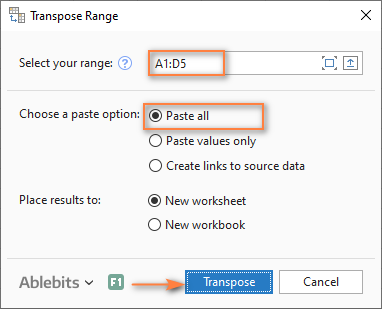


Cedarville is known for its biblical worldview, academic excellence, intentional discipleship, and authentic Christian community. Keywords: Office, color, colors, filter, sort, rows, columns, apply, enhance, table Share This PostĬedarville offers more than 150 academic programs to grad, undergrad, and online students. (Hover over the various table styles to see a live preview.) Choose a style/color option that appeals to you.Click the "Design" tab > Locate the "Table Styles" group.Well, if I transpose the rows and columns, I end up with thousands and thousands of columns that I also have no idea what to do with. That way, the userID will be the leftmost column. Click on a cell in the table to activate the "Table Tools" tab. How to use the macro to convert row to column. First thing first, I recommend taking your source table and Paste Transpose to turn the columns into rows and vice versa.Resize your columns to make the headings visible.Verify that the range is correct > Click.If you have column headings, check the box "My table has headers".Click the "Insert" tab > Locate the "Tables" group.Actually, this is the easiest option for.

Here, we will use the Paste Options from the Context Menu Bar to convert columns to rows in Excel. Now, we will be converting the columns to rows. The data shows Sales by Month in different countries.

If you leave the date values in a single column, then you can use DAX Time INtelligence measures to calculate the differences between Years, Quarters, etc. It's written for Excel, but Power BI has the same functionality, just different looking buttons, so see this post for what it looks like in Power BI, but Mynda in the link above explains things really you pivot the data then your column to column calculations will NOT update automatically - you will need to redefine the calculations each month to include the new month's data. If you leave the date values in a single column, then you can use DAX Time INtelligence measures to calculate the differences between Years, Quarters, etc.Ī date table can make quarters, year to date, etc comparisons easier, then use functions like TOTALYTD, DATEADD, etc:įor updating your report with new Excel file each month, see if this helps: You pivot the data then your column to column calculations will NOT update automatically - you will need to redefine the calculations each month to include the new month's data.


 0 kommentar(er)
0 kommentar(er)
